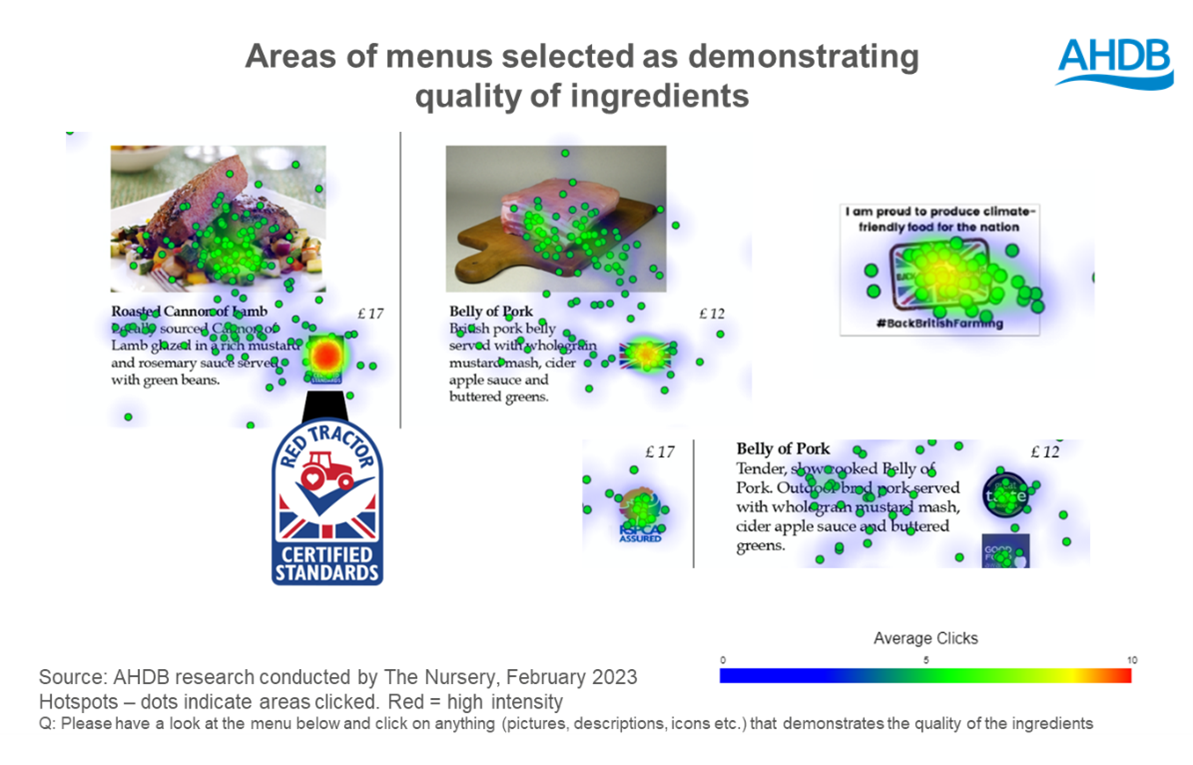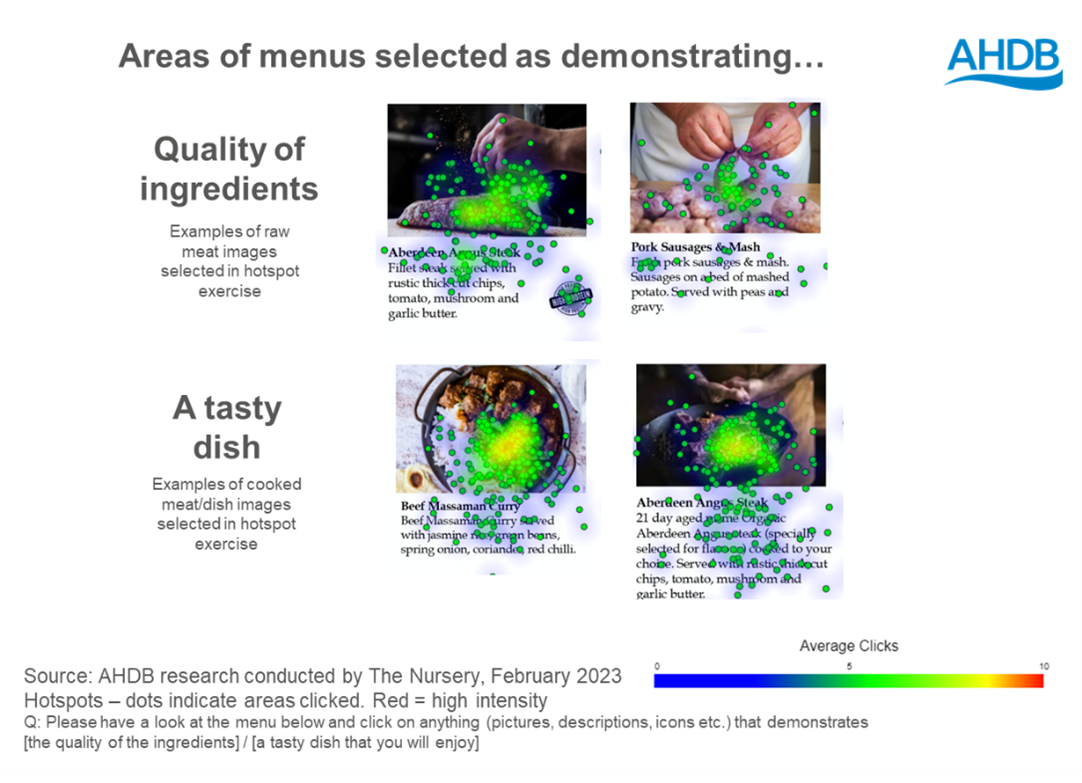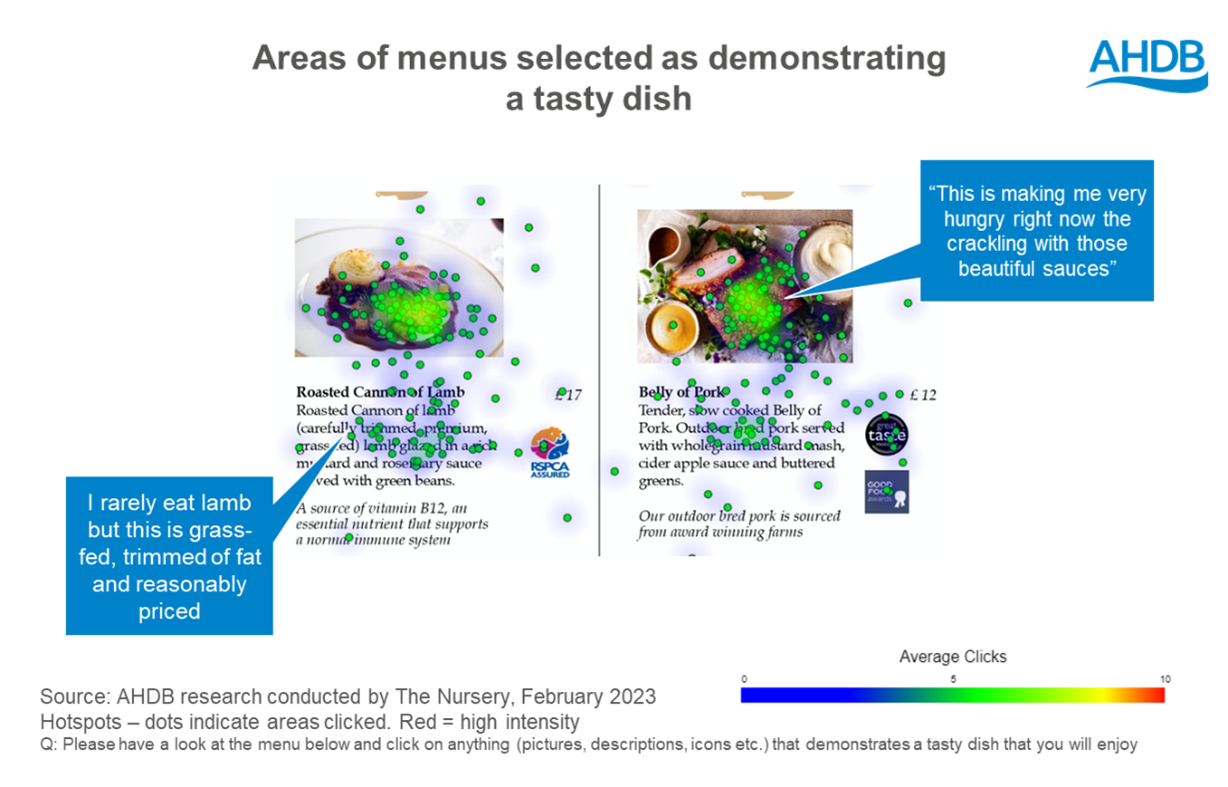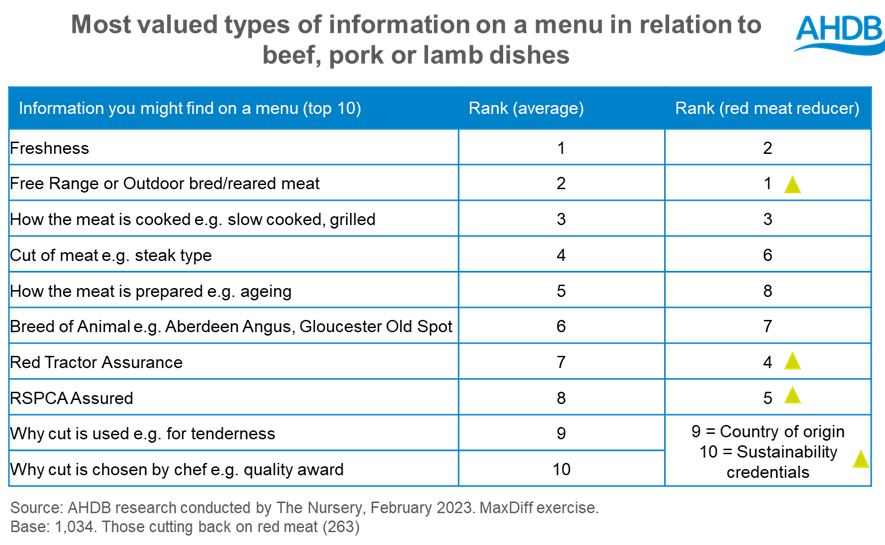- Home
- Part 2 - Communicate red meat quality, taste and reputational credentials
Part 2 - Communicate red meat quality, taste and reputational credentials
Part 1 – Get the menu and dish choices right for your diner
Part 3 – The positive impact on red meat and other opportunities
Quality drives enjoyment and quality cues for red meat are beneficial
Quality, and therefore communicating quality, is a key requirement for enjoyment. People eat with their eyes, ears and imagination long before the food reaches the table.
In the consumers’ eyes, responsibility for quality when dining out is different to when buying groceries. In the supermarket, the shopper takes on the responsibility for the quality of the meat they bring their family. In the pub/restaurant, the responsibility lies with the venue. The starting assumption is that all meat in the restaurant is vetted and meets minimum quality standards.
While on the face of it, consumers do not want to be reminded of the animal and process taken to get the meat on their plate, there is certainly a key role for accreditations to play in elevating quality perceptions at an intuitive level.
When presented with mock menus and asked to select which areas signalled meat quality to them, logos and accreditations were clear indicators. Standards and Britishness combined was meaningful to them, with the union flag, Red Tractor logo and RSPCA Assured logo being trusted, intuitive icons.
While consumers may not necessarily fully understand these accreditations, they appear to simplify a message and act as a stamp of approval. There is a level of trust put into these standards (and the foodservice operator) and they therefore do not desire further education on what they mean and how they vary. The same is true when it comes to descriptors and wording. Organic and free range are associated with a higher quality eating experience, while outdoor reared and grass fed also impact quality perceptions, even if not fully understood.

We understand that applying these logos or names to menus can be difficult in practice. However, the results show that, when committed sourcing takes place, how beneficial these claims can be to drive quality perceptions towards the red meat industry, the food itself and the pub/restaurant.
Where logos or flags can’t be used, there are other ways to help signal quality. Descriptors around preparation method, such as the ageing period for steaks, were an indicator of how flavoursome the meat would be. Imagery can also have a role to play. While not typically featured on menus, consumers are receptive to images of the food. There is a preference for cooked meal or cooking images overall however, images of raw / cooking meat aren’t rejected if used in the right way and have a role to play in highlighting the process of it being made with care, as well as freshness of ingredients.

A local butcher reference can play a role in indicating quality too; butchers are perceived to handle/process higher quality meats. When asked who they are most likely to listen to when it comes to promoting British beef, lamb and pork, butchers were the highest scoring (34%), although there is a role for farmers (31%) and bodies such as the Food Standards Agency (29%). However, the butchers’ role should be via name/description only, as people do not want an image of the butcher, instead preferring food imagery.
Sustainability reassures but isn’t top of mind when selecting a dish from the menu
Hearing about how a meat was sustainable, or improving its sustainability credentials, was unarguably a positive step for consumers. However, it did not enhance their perception of enjoyment or quality of a dish or experience. It was a ‘good to know’ but there was no consumer need for it on menu. It could boost positivity about eating red meat overall as a restaurant corporate and social responsibility (CSR) message, most likely provided on websites for those seeking this level of information but was not a key message for high impact.
Images and dish descriptions can also bolster red meat quality and taste perceptions
Quality perceptions are linked to overall perceptions of how tasty the food will be. However, there is more that can be done to build on this.
When it comes to taste, images have a stronger impact than words, with cooked meat images better at demonstrating a tasty dish. However, a description still contributes to the perception of taste and information about the meat preparation (how it has been prepared and cooked) scored highly in demonstrating tastiness. This could potentially be of particular importance for lamb, which has barriers around fattiness, and language around trimming or leanness held appeal.

Descriptive words evoking taste/flavour, occasion and experience and signs of quality attract people to red meat. For instance, “tender lamb chops” and “mouth-watering steak” suggest a sensory experience, “30 day aged” creates an impression of premium quality, and “specially selected for flavour” implied quality and care. The more evocative and detailed the description is of the meat and dish, the higher the perception of the quality (and perceived value/expected expense).
When it comes to descriptors, it is information that demonstrates quality which diners want to see. Freshness ranked highest, tying in with findings from our research into red meat reputation in the online grocery market. Farming, sourcing and preparation messages are also most important on a menu, particularly for those cutting back on red meat. For these reducers, free-range and outdoor meat claims, as well as assurance schemes, were of greater importance and could offer more reassurance.

Restaurants should not underestimate their role in influencing consumers’ perceptions of British red meat. They were deemed the top promoter of taste, linking back to that consumer trust in chefs’ skills to create something they would struggle to at home.
Awards can play a part in signalling this to consumers and needn’t be consigned to the website alone. A quality award could be for the sourced product itself, or for the chef or restaurant, and needn’t be a well-known logo.
Health messaging takes lower priority on menu but can still be utilised elsewhere
For the majority, health and well-being is not a key priority when ordering from a restaurant. Indulgence continues as a key trend for the dining out market, counteracting healthiness. ‘Treat’ is the most common consumer mission for eating or drinking out of home, or when ordering delivery, and the top three food items consumed out of home are chips, burger and pizza (Lumina Intelligence).
For frequent meat eaters, they do not feel they need to justify eating meat at a restaurant. They feel they can balance their overall intake of red meat at home, while the restaurant is a treat occasion.
However, health is a mainstream trend, and some people do think about how they will feel after a meal, and health can be a choice factor. Some do switch to non-red meat options to feel lighter or be healthier (for example if they feel they’ve eaten too much meat recently or are going out for drinks after dinner). Therefore, there may be an opportunity to help reassure consumers that they needn’t switch out of red meat altogether in order to seek a lighter option. Easy to view icons calling out ‘high in protein’, ‘lighter’ or ‘lean’ could provide a subconscious way to retain consumers. While 43% said they would expect to find health and wellbeing information on the menu, more people (52%) said they’d expect it on the venue’s website.
Calorie labelling on menus (mandatory for operators with more than 250 staff) is recognised, with 59% of consumers noticing calorie labelling when eating out or ordering food (AHDB/YouGov Consumer Tracker, Nov 2022). In our research, we chose not to include calorie labelling as we know the levels of recognition and how it can influence food choice when dining out. Instead, we opted for the focus to be on exploring other ways to reassure consumers of the quality and benefits of red meat when dining out.
Part 1 – Get the menu and dish choices right for your diner
Part 3 – The positive impact on red meat and other opportunities
Sign up to receive the latest information from AHDB
While AHDB seeks to ensure that the information contained on this webpage is accurate at the time of publication, no warranty is given in respect of the information and data provided. You are responsible for how you use the information. To the maximum extent permitted by law, AHDB accepts no liability for loss, damage or injury howsoever caused or suffered (including that caused by negligence) directly or indirectly in relation to the information or data provided in this publication.
All intellectual property rights in the information and data on this webpage belong to or are licensed by AHDB. You are authorised to use such information for your internal business purposes only and you must not provide this information to any other third parties, including further publication of the information, or for commercial gain in any way whatsoever without the prior written permission of AHDB for each third party disclosure, publication or commercial arrangement. For more information, please see our Terms of Use and Privacy Notice or contact the Director of Corporate Affairs at info@ahdb.org.uk © Agriculture and Horticulture Development Board. All rights reserved.

